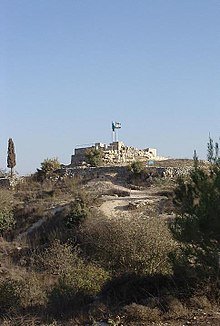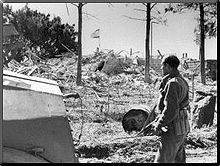Castel (Israel)
Castel ( Arabic لقسطل, DMG al-Qasṭal , Hebrew הקסטל HaKastel ) is a former Roman site and fortress, today an Israeli national park and a memorial at the eastern end of Bab el Wad , about 5 km west of Jerusalem .
geography
Castel consists of a fortress of Roman origin on a hill 790 m, a former quarry and the former Arab village of Al-Qastal, both of which are south of the hill. The main road from Jerusalem to Tel Aviv runs directly north at the foot of the hill . Due to Castel's importance in the Israeli War of Independence , the hill is a memorial site operated by the Israel Nature & National Parks Protection Authority .
history
Various historians identify Castel as the biblical Efron (see Book of Joshua 15 : 9), a border town on the territory of the tribe of Judah . During the Roman rule over Judah, Castel was turned into a fortress to control the road to Jerusalem. The Belveer Fortress was built here during the Crusader period. Only towards the end of the British mandate in Palestine did the hill regain importance.
When the hostilities between Arabs and Jews increased after the UN partition resolution for Palestine in November 1947, the road to Jerusalem was blocked by Arab rioters for the supply convoys for the besieged Jewish part of Jerusalem. Castel was of great strategic importance. Abd al-Qadir al-Husaini was in command here in April 1948 .
A particularly serious incident occurred on December 26, 1947 , when a transport organized by the Children and Youth Alijah with Jewish refugee children on the way from Tel Aviv to Jerusalem near Castel came under fire from Arab rioters. The transport was accompanied by the then head of the organization, Hans Beyth , Golda Meir, and another representative of the Jewish Agency . Beyth returned the fire with his handgun and was killed in the subsequent firefight. Remembered today u. a. a main thoroughfare in Jerusalem.
In connection with Operation Nachshon , in which the siege of Jerusalem was to be blown up with 335 vehicles and 1,500 Jewish soldiers and supplies to the city were to be resumed, Castel was initially taken by 100 men in a coup on April 2, 1948. However, these were pushed back by al-Husaini militants. On the night of April 6th, three battalions of the Hagana and Palmach attacked again and were able to take Castel again. In the course of the next few days there was bitter trench warfare, with the Jewish fighters being pushed back to the top of the hill and then retreating north. Palestinian commander al-Husseini fell during the last decisive fighting in the early hours of April 8. Having lost their charismatic leader, the Arab morale collapsed and the fighters withdrew. With that, Castel was neither in Jewish nor in Arab hands for a few hours. On the night of April 9, the fourth Palmach battalion reached Castel, which subsequently remained in Jewish hands.
The strategic goal of ending the Arab siege of Jewish Jerusalem, however, could not be achieved because the Arab blockade was relocated to the western end of the Bab el Wad near Latrun . Only the completion of the Burma Road , an alternative route further south, in June 1948, could the siege finally end.
The Arab village of Castel, like five others, was conquered by the Jewish armed forces, making it the first Jewish military territory to be conquered in the Palestine War. The residents of Castel fled, also under the impression of the recent Deir Yassin massacre . The Ma'oz Zion neighborhood in Jerusalem now stands on the site of the former village.
memorial
The entire hill with the fortress ruins and the trenches is a memorial today. Memorial plaques and bronze reliefs depict the course of the fighting in April 1948. Tree planting was carried out on the site of the memorial in cooperation with the Jewish National Fund .
Web links
- Castel National Park at Israel Nature and Parks Authority (English)
Coordinates: 31 ° 47 ′ 49 ″ N , 35 ° 8 ′ 39 ″ E

